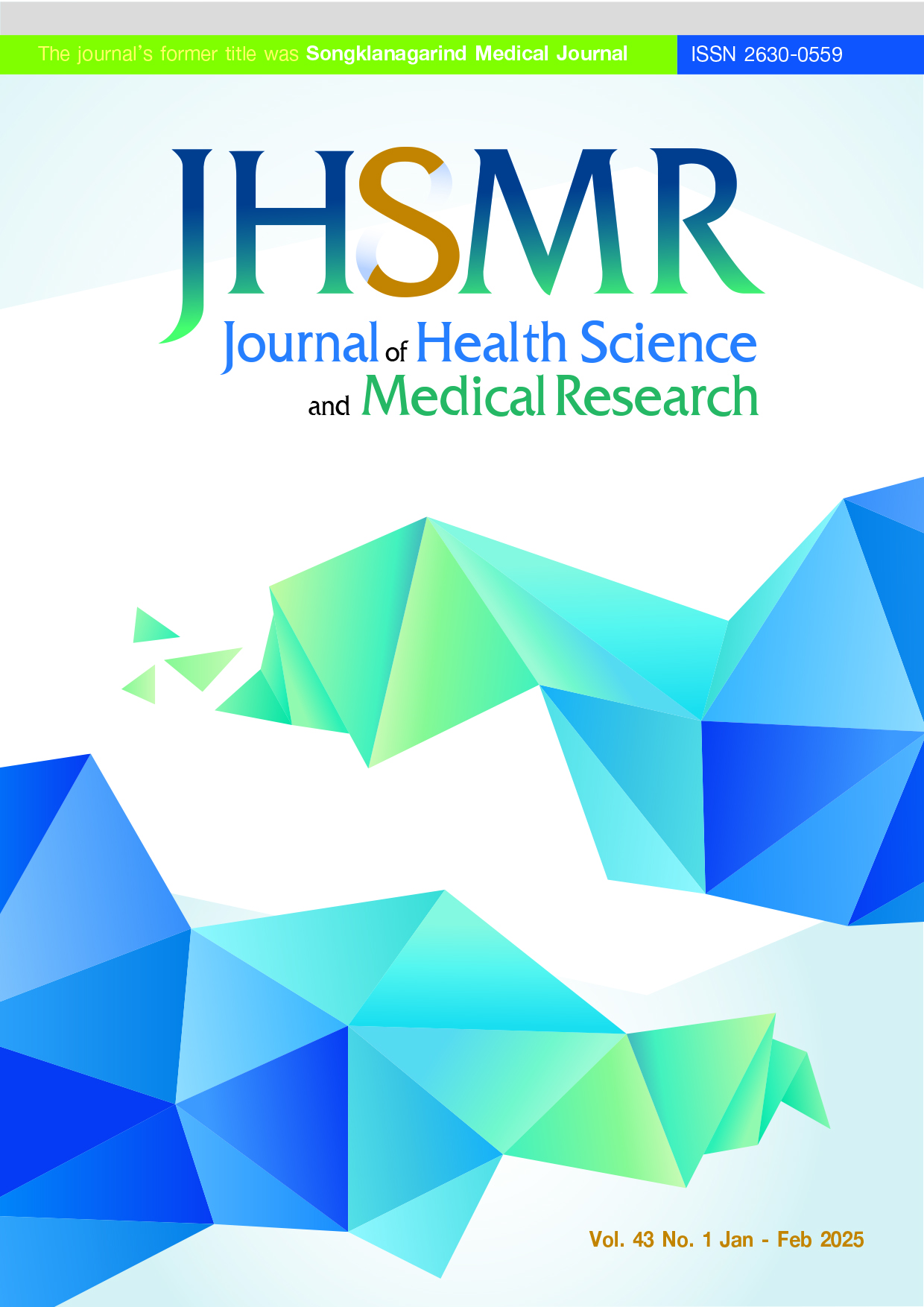Risk Factors for Anastomotic Leakage after Rectal Surgery in Locally Advanced Rectal Cancer
DOI:
https://doi.org/10.31584/jhsmr.20241073Keywords:
anastomosis leakage, locally advanced rectal cancer, neoadjuvant chemoradiation, risk factorsAbstract
Objective: To identify the risk factors for anastomosis leakage (AL) after rectal resection for locally advanced rectal cancers (LARCs) treated with neoadjuvant chemoradiation (nCRT).
Material and Methods: A retrospective risk factor study was conducted in LARC patients who received nCRT in Hatyai Hospital from September 2014 to September 2023. The patients were classified into two groups, AL and no anastomotic leak (No-AL) groups. The variables analyzed included age, gender, body mass index (BMI), American Society of Anesthesiologists classification score (ASA), history of significant weight loss, tumor level, time interval between nCRT and surgery, the number of staples, surgical approach, estimated blood loss (EBL), packed red cell (PRC) transfusions, operative time, diverting ostomy, and type of surgery. These predictive factors were analyzed by univariable and multivariable logistic regression.
Results: One hundred and seventeen patients were included in the study. The AL rate was 8.5% and the 30-day mortality rate was zero. The study found that BMI, time interval, EBL, and PRC transfusions were associated with a significantly increased AL risk under univariable analysis. In the multivariable analysis, four factors were identified as independent risk factors for AL: BMI less than 18 kg/m2, time interval more than 11 weeks, needing packed red cells blood transfusion, and operative time more than 400 minutes.
Conclusion: Diverting stoma can reduce AL consequences but does not reduce its incidence. Diverting stoma should be considered in locally advanced rectal cancer treated with neoadjuvant chemoradiation patients with the risk factors noted above-BMI less than 18 kg/m2, time interval longer than 11 weeks, needing PRC transfusion, or operative time more than 400 minutes.
References
Branagan G, Finnis D. Prognosis after anastomotic leakage in colorectal surgery. Dis Colon Rectum 2005;48:1021-6.
Zarnescu EC, Zarnescu NO, Costea R. Updates of risk factors for anastomotic leakage after colorectal surgery. Diagnostics 2021;11:2382.
Qin Q, Ma T, Deng Y, Zheng J, Zhou Z, Wang H, et al. Impact of preoperative radiotherapy on anastomotic leakage and stenosis after rectal cancer resection: post hoc analysis of a randomized controlled trial. Dis Colon Rectum 2016;59:934-42.
Ma L, Pang X, Ji G, Sun H, Fan Q, Ma C. The impact of anastomotic leakage on oncology after curative anterior resection for rectal cancer. Medicine 2020;99:37.
Gu WL, Wu SW. Meta-analysis of defunctioning stoma in low anterior resection with total mesorectal excision for rectal cancer: evidence based on thirteen studies. World J Surg Oncol 2015;13:9.
Thornton M, Joshi H, Vimalachandran C, Heath R, Carter P, Gur U, et al. Management and outcome of colorectal anastomotic leaks. Int J Colorectal Dis 2011;26:313–20.
Rahbari NN, Weitz J, Hohenberger W, Heald RJ, Moran B, Ulrich A, et al. Definition and grading of anastomotic leakage following anterior resection of the rectum: a proposal by the international study group of rectal cancer. Surgery 2010;147:339-51.
Sauer R, Becker H, Hohenberger W, Rodel C, Wittekind C, Fietkau R, et al. Preoperative versus postoperative chemoradiotherapy for rectal cancer. NEJM 2004;351:1731-40.
Terzi C, Bingul M, Arslan NC, Ozturk E, Canda AE, Isik O, et al. Randomized controlled trial of 8 weeks’ vs 12 weeks’ interval between neoadjuvant chemoradiotherapy and surgery for locally advanced rectal cancer. Colorectal Dis 2019;22:279-88.
Marijnen CAM, Kapiteijn E, Van De Velde CJH, Martijn H, Steup WH, Wiggers T, et al. Acute side effects and complications after short-term preoperative radiotherapy combined with total mesorectal excision in primary rectal cancer: report of a multicenter randomized trial. J Clin Oncol 2002;20:817-25.
Ma B, Gao P, Wang H, Xu Q, Song Y, Huang X, et al. What has preoperative radio(chemo) therapy brought to localized rectal cancer patients in terms of perioperative and long-term outcomes over the past decades? A systematic review and meta-analysis based on 41,121 patients. Int J Cancer 2017;141:1052-65.
Hu MH, Huang RK, Zhao RS, Yang KL, Wang H. Does neoadjuvant therapy increase the incidence of anastomotic leakage after anterior resection for mid and low rectal cancer? A systematic review and meta-analysis. Color Dis 2017;19:16-26.
Qin C, Ren X, Xu K, Chen Z, He Y, Song X. Does preoperative radio(chemo)therapy increase anastomotic leakage in rectal cancer surgery? a meta-analysis of randomized controlled trials. Gastroenterol Res Pract 2014;2014:1–7.
Messaris E, Connelly TM, Kulaylat AN, Miller J, Gusani NJ, Ortenzi G, et al. Is a diverting ostomy needed in mid-high rectal cancer patients undergoing a low anterior resection after neoadjuvant chemoradiation? An NSQIP analysis. Surgery 2015;158:686-91.
Ahmad NZ, Abbas MH, Khan US, Parvaiz A. A meta-analysis of the role of diverting ileostomy after rectal cancer surgery. Int J Colorectal Dis 2021;36:445–55.
Kwag SJ, Kim JG, Kang WK, Lee JK, Oh ST. The nutritional risk is a independent factor for postoperative morbidity in surgery for colorectal cancer. Ann Surg Treat Res 2014;86:206-11.
Hida J, Yasutomi M, Maruyama T, Wakano T, Uchida T, Fujimoto K, et al. Anterior resection following posterior transsacral stapling and transection of the anal canal for low-lying rectal cancer in males. Surg Today 1998;28:768-9.
Targarona EM, Balague C, Pernas JC, Matinez C, Berindoague R, Gich I, et al. Can we predict immediate outcome after laparoscopic rectal surgery? Multivariate analysis of clinical, anatomic, and pathologic features after 3-dimensional reconstruction of the pelvic anatomy. Ann Surg 2008;247:642-9.
Warschkow R, Steffen T, Thierbach J, Bruckner T, Lange J, Tarantino I. Risk factors for anastomotic leakage after rectal cancer resection and reconstruction with colorectostomy. A retrospective study with Bootstrap analysis. Ann Surg Oncol 2011;18:2772–82.
Miki C, Hir J, Inoue Y, Mohri Y, Kusunoki M. Perioperative allogeneic blood transfusion, the related cytokine response and long-term survival after potentially curative resection of colorectal cancer. Clin Oncol 2006;18:60–6.
Ito M, Sugito M, Kobayashi A, Nishizawa Y, Tsunoda Y, Saito N. Relationship between multiple numbers of stapler firings during rectal division and anastomotic leakage after laparoscopic rectal resection. Int J Colorectal Dis 2008;23:703-7.
Downloads
Published
How to Cite
Issue
Section
License

This work is licensed under a Creative Commons Attribution-NonCommercial-NoDerivatives 4.0 International License.
























